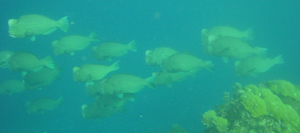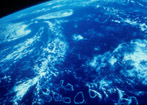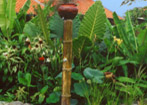Rossel Islands, Papua New Guinea
14th-22nd April 2006
We anchored at the pass into Rossel Lagoon. We dived around several
reef patches where we found extremely healthy fish life including
a school of thirty large dogtooth tuna. On one dive more than
ten sharks were present. The hard coral cover was sparse in places
but in other areas was dense and thriving. There were also some
beautiful sea fan gardens and a school of 30 bumphead parrotfish.

We spent a little longer at this anchorage than intended due
to the development of Cyclone Monica – it began as a low
pressure over our heads but thankfully did not become cyclonic
until it had moved two hundred miles southwest of us, towards
the Australia coast. It struck land on Wednesday morning with
winds up to 100 knots according to our weather faxes.
On Tuesday morning, under grey skies, we moved to anchor in Tryon
Bay where steep hills rise around us.
Our ship’s work began in earnest. Heraclitus now has a
glistening black hull with bright eyes and fiery red portholes.
It has been a challenge – with rain showers arriving every
few hours but the task in hand has been completed by this merry
band of sailors!
  
painters and hull celeaners at work on Heraclitus!
The Rossel Islands are the furthest outpost of the Massim –
the southeastern tip of Papua New Guinea. This atoll is important
in the Milne Bay region because, although not formally part of
the kula ring, it is here that red shell necklaces - the bagi
or soulava – are manufactured from the shells of the Chama
pacificus oyster. Kula players from the Trobriands and other islands
purchase these necklaces and then feed them in to their kula rings.
The value of a kula necklace is gauged in the thinness of the
discs, the uniformity of the polish and the colour of the shell
– reddish-pink is more favoured than dark red.
We made expeditions to find the makers of the bagi necklaces.
Guides from the nearest village to Heraclitus brought us across
the island's coast to the home of master craftsmen where they
demonstrated for us the intricate work involved in making each
necklace.

the shells, skilfully plucked from the reef



hammering the shells to retrieve splinters
of red which will then be drilled and ground to create the necklaces

the grinding stone with a string of beads
to be shaped into a fine string
For us, departing the Rossel Islands was a farewell to Melanesia.
We have spent over a year here in Fiji, Vanuatu, Solomon Islands
and Papua New Guinea. Australia and the Great Barrier Reef are
the next stop for us where we will spend five months before returning
to Milne Bay for the canoe festival at the end of the year.
|









